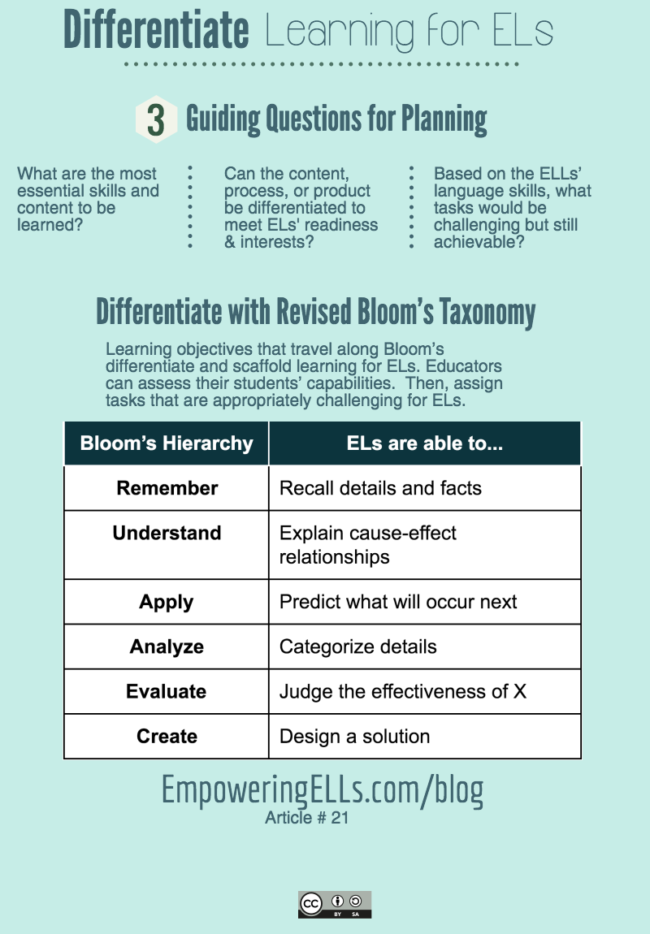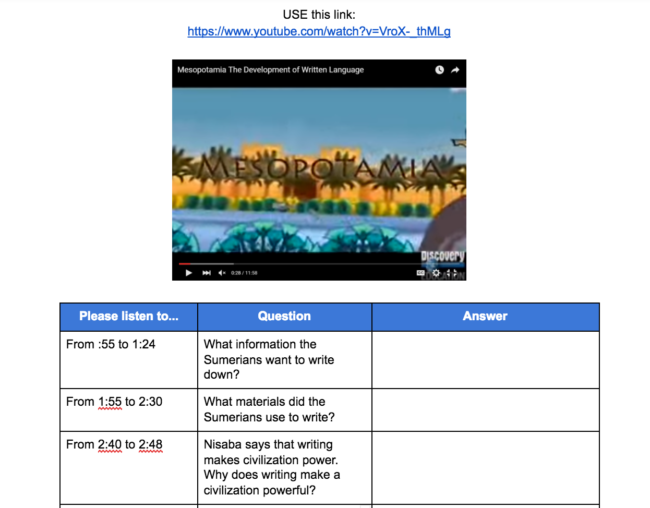Part 3 of WIDA’s Essential Action Series. Click here to return to the first article in the series.

The third article in WIDA’s Essential Actions: A Handbook for Implementing WIDA’s Framework for English Language Development Standards is titled, “Apply the background knowledge of ELLs, including their language proficiency profiles, in planning differentiated language teaching. Gottlieb writes:
Every student has a distinct personality, life history, and educational background. Influenced by these experiences and opportunities, every language learner, at any given time, has a unique language learning profile with varying levels of proficiency in each of the domains of listening, speaking, reading, and writing. By understanding students’ strengths and current levels of language proficiency, educators can plan for and monitor their progress along the language development continuum (p.26).
Once teachers can identify what ELs are able to do, they can plan differentiated lessons and assessments based on ELLs’ language profiles.
Research Suggests
Teachers can plan for learning experiences that are challenging and achievable when considering ELs’ current skills sets. In truth, teaching anything below their current skills level stands a chance of being boring and increasing the achievement gap.
Correspondingly, activities that are significantly beyond their abilities cause frustration, create negative self-perceptions, and potentially lead to seeing school as a marginalizing institution instead of a safe place to learn.
Before learning about EAL research, I believed that my ELs should do less challenging work than their native English proficient peers, so I assigned easier reading tasks and dumbed down the writing requirements. Looking back, this was an incredibly detrimental practice.
Now I realize that ELs should and can be exposed to learning experiences that are challenging but within their zone of proximal development because such experiences push ELs’ language skills to the next level (Vygotsky, 1978). In order to do this, I learned that it was my responsibility to determine students’ mastery level and plan with the mindset of what they can do instead of lament on what they cannot.
I consciously integrated scaffolds within these experiences to help ELs perform despite the challenges (Gibbons, 2002). To help me scaffold appropriately, I differentiate the learning experiences. Tomlinson (2003), Fairbairn and Jones-Vo’s (2010) research suggests that I should differentiate based on my understanding of students’ mastery of English.
A Case Study
I’d like to share an actual teaching experience that demonstrates this philosophy of differentiating based on students’ language skills. Mr. D is a 6th grade history teacher. He wanted students to explore the concept of “systems” and contextualized his lessons around systems in ancient civilizations. We co-planned weekly to find ways to make the content accessible to the EALs in the class.
During this particular week, Mr. D wanted students to watch an animated video about Mesopotamia and then answer a range of questions. Mr. D identified one EL in particular, Anny, who needed help accessing this concept.
Guiding Questions When Differentiating
When I co-plan with a content teacher like Mr. D, I use these guiding questions to help inform the differentiation and shape the scaffolding:
- What are the most essential skills and content to be learned?
- Can the content, process, or product be differentiated to meet ELs’ readiness and interests.
- Based on the ELLs’ language skills, what tasks would be challenging but still achievable?
The most important question in this set is number 3. We have to know what Anny is capable of, so we can plan a task that is within her skill set but is still challenging. To help me with this task, I use Bloom’s revised taxonomy (Anderson & Krathwohl, 2001).
Planning with Bloom’s Taxonomy
We looked at Bloom’s revised taxonomy graphic and found that Anny can perform at the first level, which is called “Remembering”. We wanted her to be challenged at the next level, which is titled “Understanding”. We then looked at the learning experience, which was to watch a video about systems Sumerians used.
Mr. D wanted Anny to view the same video as her more proficient English-speaking peers, and he wanted her to essentially do the same task, which was answer questions after viewing the video. We then decided that it was appropriate to differentiate the way Anny can engage with the video to help her remember the facts and understand the different systems in Sumerian culture.
We created a document that provided more scaffolding for Anny in the form of segmenting the videos into small, manageable units of information. There was a question assigned to each section of the video. Anny was asked to watch just one section at a time and answer the question accordingly.
Anny needed the videos to be segmented because we observed that she became overwhelmed when lots of information was presented without having time to process it. The document honored her need and built in more processing time. It also included questions that ask her to draw conclusions based on the information in the video, a skill she is trying to learn. This is what the scaffolding document looks like below.
I learned this practice of planning with Bloom’s revised taxonomy while attending a workshop held by Dragonfly, an educational consultancy offering professional development to teachers. The presenter, Indu Bedi (2016) described how we can use Bloom’s revised taxonomy to differentiate learning and scaffold tasks. I found Bedi’s practice particularly effective when co-planning with content teachers because it’s a practical strategy that identifies what ELs can do and guides our planning to push ELs to the next level.
The document that I use in particular during this process comes from the Indian Institute of Technology Madras. At each level of Bloom’s revised taxonomy, there are various verbs associated with each phase, definitions of each word, and categories of different types of thinking. The breakdown itself comes from Lori Anderson and David Krathwohl, Bloom’s students who revised his taxonomy in 2001. You might find this infographic from Global Digital Citizen helpful. It’s highly visual format makes it easy to process and return to for quick referencing.
Case Study Conclusion
I hope that this case study clearly demonstrated how teachers can plan instruction with students’ language proficiency in mind. I also hope that it offered an example of how to differentiate a task and scaffold learning using Bloom’s revised taxonomy. For me, this case study is an example of how we can teach ELs using a “can do” mindset instead of a deficit model of instruction. Differentiated and scaffolded lessons empower ELs to reach beyond teachers’ expectations.
Next Post
The next post will be about using topics from content classes as the context for learning language. I’ll share why creating context is important and provide examples of how I establish relevance for learning language.
Reference
Anderson, L. W. & Krathwohl, D. R. (2001). A Taxonomy for Learning, Teaching and Assessing: a Revision of Bloom’s Taxonomy. New York: Longman Publishing.
Bedi, I. (2016). No Hands Questioning. Penarth, UK: Dragonfly EAL.
Fairbairn, S., & Jones-Vo, S. (2010). Differentiating instruction and assessment for English language learners:A guide for K–12 teachers. Philadelphia, PA: Caslon Publishing.
Gottlieb, M. (2013). Essential Actions: A Handbook for Implementing WIDA’s Framework forEnglish Language Development Standards. Madison: Board of Regents of the U of Wisconsin System.
Gibbons, P. (2002). Scaffolding language, scaffolding learning: Teaching second language learners in the mainstream classroom. Portsmouth, NH: Heinemann.
Indian Institute of Technology Madras (2011). Revised Bloom’s Taxonomy [PDF document]. Retrieved from https://tlc.iitm.ac.in/PDF/Blooms%20Tax.pdf
Tomlinson, C. A. (2003). Fulfilling the promise of the differentiated classroom. Alexandria, VA: ASCD.
Vygotsky, L. S. (1978). Interaction between learning and development. In M. Cole, V. John-Steiner, S. Scribner, & E. Souberman (Eds.), Mind in society: The development of higher psychological processes (pp. 79–91). Cambridge, MA: Harvard University Press.


